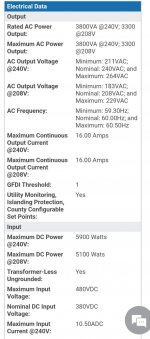titan1021
Senior Member
- Location
- Northern California
Hi all,
I have a client that has asked if I can replace their solar inverter for them. While I have been in the trade for over 22yrs I haven't dabbled in solar as of yet, so I am here hoping for a little input.
The client currently has a Sunny boy inverter that has failed, that inverter is 14yrs old. I have found a very similar Solar Edge inverter that appears to be a good replacement. I've attached the specs of each, just wondering if Solar Edge would be the correct replacement and if not is there a compatibility tool or chart etc.. out there to help locate a proper/equivalent replacement. The client doesn't want another Sunny Boy.
Shouldn't I just be able to swap the two or are there other considerations?
Thank you
I have a client that has asked if I can replace their solar inverter for them. While I have been in the trade for over 22yrs I haven't dabbled in solar as of yet, so I am here hoping for a little input.
The client currently has a Sunny boy inverter that has failed, that inverter is 14yrs old. I have found a very similar Solar Edge inverter that appears to be a good replacement. I've attached the specs of each, just wondering if Solar Edge would be the correct replacement and if not is there a compatibility tool or chart etc.. out there to help locate a proper/equivalent replacement. The client doesn't want another Sunny Boy.
Shouldn't I just be able to swap the two or are there other considerations?
Thank you



